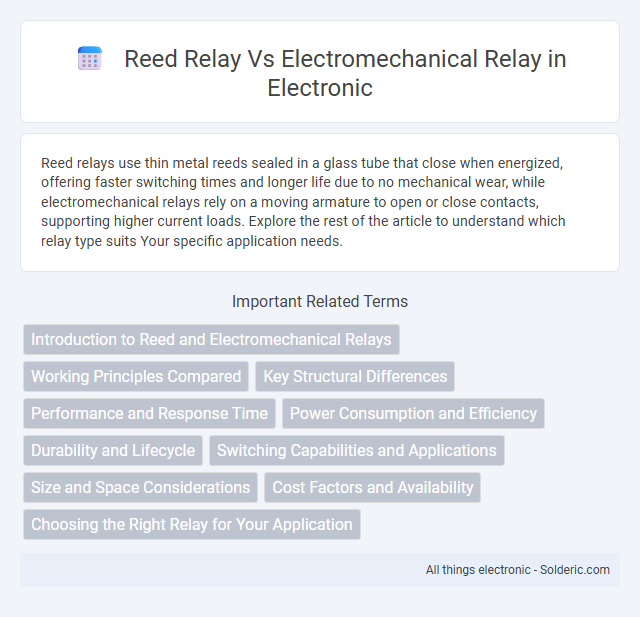Reed relays use thin metal reeds sealed in a glass tube that close when energized, offering faster switching times and longer life due to no mechanical wear, while electromechanical relays rely on a moving armature to open or close contacts, supporting higher current loads. Explore the rest of the article to understand which relay type suits Your specific application needs.
Comparison Table
| Feature | Reed Relay | Electromechanical Relay |
|---|---|---|
| Switching Mechanism | Magnetically sealed reed contacts | Mechanical armature and contacts |
| Switching Speed | Fast (milliseconds) | Slower (tens of milliseconds) |
| Contact Life | High (up to 10^9 operations) | Lower (10^5 to 10^7 operations) |
| Contact Type | Usually Normally Open (NO) | NO, Normally Closed (NC), and Changeover |
| Size | Compact, small footprint | Generally larger |
| Coil Power | Low coil power required | Higher coil power required |
| Contact Rating | Low current and voltage (up to ~10A) | Higher current and voltage ratings (up to hundreds of amps) |
| Application | Signal switching, low current circuits | Power switching, high current circuits |
| Mechanical Wear | Minimal due to sealed contacts | More wear due to mechanical movement |
| Cost | Generally higher per unit | Generally lower per unit |
Introduction to Reed and Electromechanical Relays
Reed relays use sealed reed switches activated by an electromagnetic coil, offering faster switching speeds and longer operational life due to minimal physical contact wear. Electromechanical relays consist of an electromagnetic coil and a mechanical armature that physically opens and closes contacts, providing higher current handling capability but slower switching speed and more mechanical wear. Reed relays excel in low-level signal switching and high-frequency applications, while electromechanical relays are preferred for heavy-duty and high-power circuits.
Working Principles Compared
Reed relays use magnetic fields to move thin, flexible metal reeds inside a sealed glass tube, enabling fast switching with low contact resistance and minimal electrical noise. Electromechanical relays operate by energizing a coil to create a magnetic field that physically moves a larger armature to open or close contacts, suitable for higher voltage and current applications but with slower response times. Your choice between the two depends on the required switching speed, current capacity, and signal integrity for the specific application.
Key Structural Differences
Reed relays consist of thin, ferromagnetic reeds sealed within a glass envelope, enabling fast operation and minimal contact bounce due to their small moving parts. Electromechanical relays feature larger, hinged armatures that physically open and close contacts, resulting in slower switching speeds and greater susceptibility to mechanical wear. The hermetically sealed design of reed relays ensures higher reliability in sensitive and low-current applications compared to the more exposed contact mechanism of electromechanical relays.
Performance and Response Time
Reed relays exhibit superior performance and faster response times compared to electromechanical relays, with switching speeds typically in the microsecond range versus milliseconds for electromechanical types. The sealed reed contacts minimize contact bounce and offer high reliability in low-level signal switching applications. Electromechanical relays generally provide higher current handling but sacrifice speed and precision, making reed relays ideal for ultra-fast and sensitive electronic circuits.
Power Consumption and Efficiency
Reed relays consume significantly less power compared to electromechanical relays due to their smaller coil size and lower current requirements, making them ideal for energy-efficient applications. Their faster switching speeds and reduced mechanical movement enhance operational efficiency and prolong lifespan, reducing maintenance costs. When optimizing Your system for low power consumption, reed relays offer a more efficient solution without compromising performance.
Durability and Lifecycle
Reed relays offer superior durability and longer lifecycle compared to electromechanical relays due to their sealed construction and lack of physical contacts subject to wear. Electromechanical relays experience contact erosion and mechanical fatigue, which reduces their lifespan under heavy switching conditions. Your choice between these relays should consider the application's switching frequency and reliability requirements, with reed relays preferred for high-cycle, low-power uses.
Switching Capabilities and Applications
Reed relays offer faster switching speeds and higher sensitivity, making them ideal for low-level signal switching and precision measurement applications. Electromechanical relays handle higher power loads and are commonly used in industrial control systems, motor controls, and heavy-duty switching tasks. Your choice between reed and electromechanical relays depends on the switching speed, current rating, and specific application requirements.
Size and Space Considerations
Reed relays are significantly smaller and more compact than electromechanical relays, making them ideal for applications with strict space constraints such as telecommunications and test equipment. Their low-profile design enables integration into densely packed circuit boards where minimizing size is critical. Your choice of a reed relay can optimize space without compromising switching performance in compact electronic assemblies.
Cost Factors and Availability
Reed relays generally come at a higher cost due to their precision construction and specialized glass encapsulation, which enhances durability and switching speed, making them ideal for sensitive applications. Electromechanical relays are more widely available and typically less expensive, benefiting from mass production and simpler design, thus suiting broader, cost-sensitive uses. Your choice between the two should consider budget constraints and the specific availability of relay types in the market to balance performance and cost-effectiveness.
Choosing the Right Relay for Your Application
Reed relays offer faster switching speeds, lower contact resistance, and longer operational life, making them ideal for sensitive, high-frequency, or low-current applications. Electromechanical relays provide higher current and voltage handling capabilities, better suited for power control and heavy-duty switching tasks. Assessing your application's switching frequency, load requirements, and sensitivity to electrical noise will help you choose the right relay to ensure optimal performance and longevity.
reed relay vs electromechanical relay Infographic

 solderic.com
solderic.com